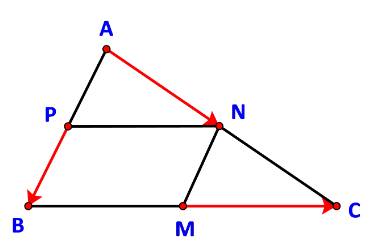Hãy nhập câu hỏi của bạn vào đây, nếu là tài khoản VIP, bạn sẽ được ưu tiên trả lời.

Tọa độ G là;
\(\left\{{}\begin{matrix}x=\dfrac{4+2+0}{3}=2\\y=\dfrac{0-4-2}{3}=-2\end{matrix}\right.\)
Tọa độ M là:
x=(2+0)/2=1 và y=(-4-2)/2=-3
Tọa độ N là:
x=(4+0)/2=2 và y=(0-2)/2=-1
Tọa độ P là;
x=(4+2)/2=3 và y=(0-4)/2=-2
Tọa độ trọng tâm của tam giác MNP là:
\(\left\{{}\begin{matrix}x=\dfrac{1+2+3}{3}=2\\y=\dfrac{-3-1-2}{3}=-2\end{matrix}\right.\)
=>Tam giác ABC và tam giác MNP có chung trọng tâm

a) Vì M, N, P lần lượt là trung điểm của BC, CA, AB
Nên AM, BN, CP lần lượt là đường trung tuyến của BC, CA, AB.
\(\Rightarrow\overrightarrow{AM}+\overrightarrow{BN}+\overrightarrow{CP}=\overrightarrow{0}\)
Lời giải:
a)
\(\overrightarrow{AM}+\overrightarrow{BN}+\overrightarrow{CP}=\overrightarrow{AB}+\overrightarrow{BM}+\overrightarrow{BC}+\overrightarrow{CN}+\overrightarrow{CA}+\overrightarrow{AP}\)
\(\overrightarrow{AM}+\overrightarrow{BN}+\overrightarrow{CP}=\overrightarrow{AC}+\overrightarrow{CM}+\overrightarrow{BA}+\overrightarrow{AN}+\overrightarrow{CB}+\overrightarrow{BP}\)
\(\Rightarrow 2(\overrightarrow{AM}+\overrightarrow{BN}+\overrightarrow{CP})=(\overrightarrow{AB}+\overrightarrow{BA})+(\overrightarrow{BM}+\overrightarrow{CM})+(\overrightarrow{BC}+\overrightarrow{CB})+(\overrightarrow{CA}+\overrightarrow{AC})+(\overrightarrow{AP}+\overrightarrow{BP})+(\overrightarrow{CN}+\overrightarrow{AN})\)
\(=\overrightarrow{0}+\overrightarrow{0}+\overrightarrow{0}+\overrightarrow{0}+\overrightarrow{0}+\overrightarrow{0}=\overrightarrow{0}\) (do các cặp tổng đều là vecto đối nhau)
\(\Rightarrow \overrightarrow{AM}+\overrightarrow{BN}+\overrightarrow{CP}=0\)
(đpcm)
b) Theo phần a:
\(\overrightarrow{AM}=-(\overrightarrow{BN}+\overrightarrow{CP})=-\overrightarrow{BN}+(-\overrightarrow{CP})\)
\(=\overrightarrow{NB}+\overrightarrow{PC}\) (đpcm)


Do M, N, P lần lượt là trung điểm của BC, CA, AB
\( \Rightarrow MN = \frac{{AB}}{2} = PB\) và MN // PB.
\( \Rightarrow \overrightarrow {PB} = \overrightarrow {NM} \)
Ta có: \(\overrightarrow {PB} + \overrightarrow {MC} = \overrightarrow {NM} + \overrightarrow {MC} = \overrightarrow {NC} \)
Lại có: \(\overrightarrow {NC} = \overrightarrow {AN} \) (do N là trung điểm của AC)
Vậy \(\overrightarrow {PB} + \overrightarrow {MC} = \overrightarrow {AN} \)

\(\overrightarrow{BM}+\overrightarrow{CN}+\overrightarrow{AP}\)
\(=\dfrac{1}{2}\left(\overrightarrow{BC}+\overrightarrow{CA}+\overrightarrow{AP}\right)\)
\(=\overrightarrow{0}\)
\(VT=\overrightarrow{AM}+\overrightarrow{BN}=\dfrac{1}{2}\left(\overrightarrow{AB}+\overrightarrow{AC}+\overrightarrow{BA}+\overrightarrow{BC}\right)=\dfrac{1}{2}\left(\overrightarrow{AC}+\overrightarrow{BC}\right)=-\dfrac{1}{2}\left(\overrightarrow{CA}+\overrightarrow{CB}\right)=\overrightarrow{PC}=VP\)